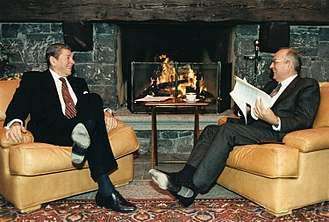Détente
Détente (French pronunciation: [detɑ̃t], meaning "relaxation")[1] is the easing of strained relations, especially in a political situation, through verbal communication. The term in diplomacy originates around 1912 when France and Germany tried, without success, to reduce tensions.[2]
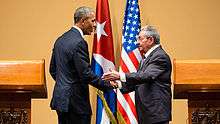
.jpg)
Most often the term is used for a phase of the Cold War. It was the policy of relaxing tensions between Moscow and the West, as promoted by Richard Nixon, Henry Kissinger and Leonid Brezhnev, 1969 – 1974. With the United States showing weakness at the top that forced Richard Nixon out of office, Brezhnev used the opportunity to expand Soviet influence. The Soviet invasion of Afghanistan in 1979 decisively ended any talk of détente.[3][4]
Cold War
The term is most often used in reference to a period of general easing of the geo-political tensions between the Soviet Union and the United States; it was the distinct lessening of the Cold War. It began in 1969, as a core element of the foreign policy of U.S. president Richard Nixon, in an effort to avoid nuclear escalation. The Nixon administration promoted greater dialogue with the Soviet government, including regular summit meetings and negotiations over arms control and other bilateral agreements.[4] Détente was known in Russian as разрядка (razryadka, loosely meaning "relaxation of tension").
The period was characterized by the signing of treaties such as SALT I and the Helsinki Accords. Another treaty, SALT II, was discussed but never ratified by the United States. There is still ongoing debate amongst historians as to how successful the détente period was in achieving peace.[5][6]
After the Cuban Missile Crisis of 1962, the two superpowers agreed to install a direct hotline between Washington D.C. and Moscow (the so-called red telephone), enabling leaders of both countries to quickly interact with each other in a time of urgency, and reduce the chances that future crises could escalate into an all-out war. The U.S./USSR détente was presented as an applied extension of that thinking. The SALT II pact of the late 1970s continued the work of the SALT I talks, ensuring further reduction in arms by the Soviets and by the U.S. The Helsinki Accords, in which the Soviets promised to grant free elections in Europe, has been called a major concession to ensure peace by the Soviets.
Détente ended after the Soviet intervention in Afghanistan, which led to the United States boycott of the 1980 Olympics in Moscow. Ronald Reagan's election as president in 1980, based in large part on an anti-détente campaign,[7] marked the close of détente and a return to Cold War tensions. In his first press conference, President Reagan said "Détente's been a one-way street that the Soviet Union has used to pursue its aims."[8] Following this, relations turned increasingly sour with the unrest in Poland,[9][10] end of the SALT II negotiations, and the NATO exercise in 1983 that brought the superpowers almost on the brink of nuclear war.[11]
Summits and treaties
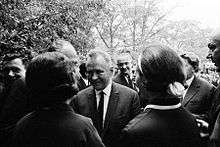
The most obvious manifestation of détente was the series of summits held between the leaders of the two superpowers and the treaties that resulted from these meetings. In the early 1960s, before détente, the Partial Test Ban Treaty had been signed on 5 August 1963. Later in the decade, the Outer Space Treaty, in January 1967, and the Nuclear Non-Proliferation Treaty, July 1968, were two of the first building blocks of détente. These early treaties were signed all over the globe.
The most important treaties were not developed until the Nixon Administration came into office in 1969. The Political Consultative Committee of the Warsaw Pact sent an offer to the West, urging them to hold a summit on "security and cooperation in Europe". The West agreed and talks began towards actual limits in the nuclear capabilities of the two superpowers. This ultimately led to the signing of the SALT I treaty in 1972. This treaty limited each power's nuclear arsenals, though it was quickly rendered out-of-date as a result of the development of MIRVs. In the same year that SALT I was signed, the Biological Weapons Convention and the Anti-Ballistic Missile Treaty were also concluded. Talks on SALT II also began in 1972.
Brezhnev however at the start of the period in his speeches to the Politburo, was intent on using the period of relaxed tensions to prepare for Soviet expansion in the 1980s.[12]
In 1975, the Conference on Security and Cooperation in Europe met and produced the Helsinki Accords, a wide-ranging series of agreements on economic, political, and human rights issues. The CSCE was initiated by the USSR, involving 35 states throughout Europe.[13] Among other issues, one of the most prevalent and discussed after the conference was that of human rights violations in the Soviet Union. The Soviet Constitution directly violated the Declaration of Human Rights from the United Nations, and this issue became a prominent point of separation between the United States and the Soviet Union.[14]
The Carter administration had been supporting human rights groups inside the Soviet Union, and Leonid Brezhnev accused the administration of interference in other countries' internal affairs.[14] This prompted intense discussion of whether or not other nations may interfere if basic human rights are being violated, such as freedom of speech and religion. The basic disagreement in the philosophies of a democracy and a single-party was in a state that did not allow for reconciliation of this issue. Furthermore, the Soviets proceeded to defend their internal policies on human rights by attacking American support of countries like South Africa and Chile, which were known to violate many of the same human rights issues.[14]
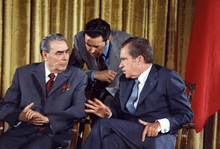
In July of the same year, the Apollo–Soyuz Test Project became the first international space mission, wherein three American astronauts and two Soviet cosmonauts docked their spacecraft and conducted joint experiments. This mission had been preceded by five years of political negotiation and technical co-operation, including exchanges of U.S. and Soviet engineers between the two countries' space centers.
Trade relations between the two blocs increased substantially during the era of détente. Most significant were the vast shipments of grain that were sent from the West to the Soviet Union each year, which helped make up for the failure of kolkhoz, Soviet collectivized agriculture.
At the same time, the Jackson–Vanik amendment, signed into law by Gerald Ford on 3 January 1975, after a unanimous vote by both houses of the United States Congress, was designed to leverage trade relations between the U.S. and the USSR, making the United States' involvement dependent upon improvements of human rights within the Soviet Union, in particular allowing refuseniks to emigrate; it added to the Most Favoured Nation status a clause that provided that no countries resisting emigration could be awarded this status. This provided Jackson with a method of linking geopolitics to human rights.[15]
The end of the Vietnam War
Nixon and his national security adviser, Henry Kissinger moved toward détente with the Soviet Union in the beginning of the 1970s. They had hopes that the Soviets would, in return, help the United States extricate or remove itself from Vietnam. People then started to notice the consciousness in which American politicians started to act with.[16]
SALT-Strategic Arms Limitations Talks
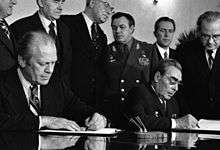
Nixon and Brezhnev signed an ABM treaty In Moscow on 26 May 1972 as well as an Interim Agreement (SALT I) temporarily capping the number of strategic arms (MIRVs, SLBMs and ICBMs). This was a show of détente militarily, the diffusion of multiplication of Nuclear Ballistic Arms started to occur.[17]
The goal of Nixon and his aide Henry Kissinger was to use arms control to promote a much broader policy of détente that could make possible the resolution of other urgent problems through what Nixon called "linkage." David Tal argues:
- The linkage between strategic arms limitations and outstanding issues such as the Middle East, Berlin and, foremost, Vietnam thus became central to Nixon’s and Kissinger’s policy of détente. Through employment of linkage, they hoped to change the nature and course of U.S. foreign policy, including U.S. nuclear disarmament and arms control policy, and to separate them from those practiced by Nixon’s predecessors. They also intended, through linkage, to make U.S. arms control policy part of détente....His policy of linkage had in fact failed. It failed mainly because it was based on flawed assumptions and false premises, the foremost of which was that the Soviet Union wanted strategic arms limitation agreement much more than the United States did.[18]
Apollo–Soyuz Hand Shake in Space

A significant example of an event which contributed to the détente was the handshake that took place in space. In July 1975, the first USSR-USA joint space flight was conducted and it was called the Apollo–Soyuz Test Project.[19] The primary goal of this project was to create an international docking system in order to allow two different space crafts to join in orbit, this would have allowed the crews on board to collaborate on the exploration of space.[20] This project marked the end of the Space Race that started in 1957 with the launch of Sputnik, therefore allowing the tensions between the US and the USSR to decrease significantly.[21]
Continued conflicts
As direct relations thawed, increased tensions continued between the superpowers through their surrogates, especially in the Third World. Conflicts in South Asia, and the Middle East in 1973, saw the Soviet and U.S. backing their respective surrogates (such as in Afghanistan) with war material and diplomatic posturing. In Latin America, the United States continued to block any leftward electoral shifts in the region by supporting undemocratic right-wing military coups and brutal military dictatorships; during this period, there were also many communist or leftward guerrillas around the region, which were allegedly backed by the Soviets and Cuba. During much of the early détente period, the Vietnam War continued to rage. Neither side trusted the other fully and the potential for nuclear war remained constant.
Each side continued to aim thousands of nuclear warheads atop intercontinental ballistic missiles (ICBMs) at each other's cities, maintain submarines with long-range nuclear weapon capability (submarine-launched ballistic missiles or SLBMs) in the world's oceans, keep hundreds of nuclear-armed aircraft on constant alert, and guard contentious borders in Korea and Europe with large ground forces. Espionage efforts remained a high priority as defectors, reconnaissance satellites, and signal intercepts measured intentions and attempted to gain strategic advantage.
Cold War flares up in 1979
The Soviet invasion of Afghanistan In 1979 that was to shore up a struggling Pro-Soviet regime led to harsh criticisms in the capitalist west and a boycott of the 1980 Summer Olympics in Moscow. United States President Jimmy Carter boosted the U.S. defense budget and began financially aiding the President of Pakistan, General Muhammad Zia-ul-Haq, who would in turn subsidize the anti-Soviet Mujahideen fighters in the region.[22]
A contributing factor in the decline of Détente as a desirable American policy was the inter-service rivalry which existed between the American Departments of State and Defense. From 1973 to 1977 there were three Secretaries worth mentioning; Elliot Richardson, James Schlesinger, and Donald Rumsfeld. Schlesinger's time as Defense Secretary was plagued by notably poor relations with Henry Kissinger, one of the more prominent American advocates of Détente. Their poor working relationship bled into their professional relationship, and as a result an increasing number of policy clashes began to accrue. These clashes would ultimately result in Schlesinger's dismissal in 1975. However, his replacement, Donald Rumsfeld, shared Shlesinger's distaste for Kissinger.
As a result, the clashes on policy between the State Department and the Defense Department continued. Rumsfeld thought that Kissinger was too complacent about growing Soviet strength. While Rumsfeld largely agreed with Kissinger's assessment that the United States possessed superior military strength when compared with the Soviet Union, he argued that Kissinger's public optimism would prevent Congress from giving the Department of Defense the funds which Rumsfeld believed were required to maintain the favorable gap between the US and the Soviets. In response, Rumsfeld regularly presented a more alarmist view of the superior strength of the Soviet superpower, which he credited with convincing Congress to increase military spending.
In response to the stranglehold of influence which Kissinger possessed in the Nixon and Ford Administrations and the subsequent decline in influence over foreign policy by the Department of Defense, Richardson, Schlesinger, and Rumsfeld used growing popular antipathy for the Soviet Union in the United States to undermine Kissinger's attempts to achieve a comprehensive arms reduction treaty and thereby portray the entire notion of Détente as an untenable policy.[23]
The 1980 American presidential election saw Ronald Reagan elected on a platform opposed to the concessions of détente. Negotiations on SALT II were abandoned as a result. However, during the later years of Reagan's presidency, he and Gorbachev pursued a policy that is considered détente.[24][25] Despite this, the Reagan administration talked about a "winnable" nuclear war, leading to the creation of the Strategic Defense Initiative and the Third World policy, funding irregular and paramilitary death squads in Central America, sub-Saharan Africa, Cambodia, and Afghanistan.[4]
See also
| Look up détente in Wiktionary, the free dictionary. |
- Containment
- Entente (type of alliance)
- Rollback
- Russian reset
- Cuban thaw
- 2018 North Korea–United States Singapore Summit
- 2018 Russia–United States summit
References
- "détente - traduction". Dictionnaire Français-Anglais WordReference.com (in French).
- John F. V. Keiger (1983). France and the Origins of the First World War. pp. 69–70. ISBN 9781349172092.
- Pons, Silvio; Service, Robert, eds. (2010). Dictionary of 20th Century Communism. pp. 73, 274–78.
- Hunt, Michael (2015). The world transformed : 1945 to the present : a documentary reader. New York, NY: Oxford University Press. p. 269–274. ISBN 978-0-19-937103-7. OCLC 870439207.
- "The Rise and Fall of Détente, Professor Branislav L. Slantchev, Department of Political Science, University of California – San Diego 2014" (PDF). Archived from the original (PDF) on 23 October 2014. Retrieved 22 July 2014.
- Nuti, Leopoldo (11 November 2008). The Crisis of Détente in Europe. ISBN 9780203887165. Retrieved 22 July 2014.
- "Ronald Reagan, radio broadcast on August 7th, 1978" (PDF). Retrieved 22 July 2014.
- "Ronald Reagan. January 29, 1981 press conference". Presidency.ucsb.edu. 29 January 1981. Retrieved 22 July 2014.
- "Detente Wanes as Soviets Quarantine Satellites from Polish Fever". Washington Post. 19 October 1980.
- Simes, Dimitri K. (1980). "The Death of Detente?". International Security. 5 (1): 3–25. doi:10.2307/2538471. JSTOR 2538471.
- "The Cold War Heats up – New Documents Reveal the "Able Archer" War Scare of 1983". 20 May 2013.
- Gus W. Weiss. "videofact"
- Lapennal 1977, p. 1
- Lapennal 1977, pp. 14–15
- Kissinger, Henry (1995). Diplomacy. ISBN 0-671-51099-1. OCLC 32350622.
- Rhodes 2008, p. 61
- Rhodes 2008, p. 112
- David Tal, " 'Absolutes' and 'Stages' in the Making and Application of Nixon’s SALT Policy." Diplomatic History 37.5 (2013): 1090-1116, quoting pp 1091, 1092. Nixon himself later wrote, "[W]e decided to link progress in such areas of Soviet concern as strategic arms limitation and increased trade with progress in areas that were important to us -– Vietnam, the Mideast, and Berlin. This concept became known as linkage.” Richard Nixon (1978). RN: The Memoirs of Richard Nixon. p. 346. ISBN 9781476731834.
- "NASA - Handshake in Space". Nasa.gov. 1 March 2010. Retrieved 30 September 2018.
- Morgan, Kellie (15 July 2015). "Celebrating historic handshake in space, 40 years later". CNN. Retrieved 30 September 2018.
- Samuels, Richard J., ed. (21 December 2005). Encyclopedia of United States National Security (1st ed.). SAGE Publications. p. 669. ISBN 978-0-7619-2927-7. Retrieved 25 May 2016. Most observers felt that the U.S. moon landing ended the space race with a decisive American victory. […] The formal end of the space race occurred with the 1975 joint Apollo-Soyuz mission, in which U.S. and Soviet spacecraft docked, or joined, in orbit while their crews visited one another's craft and performed joint scientific experiments
- Raymond L. Garthoff, Detente and confrontation: American-Soviet Relations From Nixon to Reagan (1985).<Online free to borrow
- http://history.defense.gov/Portals/70/Documents/special_studies/SpecStudy7.pdf
- "Reagan, Gorbachev two paths of Détente". Washington Post. Washington Post, 29 May 1988. 29 May 1988.
- Norman Podhoretz (January 1984). "The First Term: The Reagan Road to Détente". Foreign Affairs (America and the World 1984).
Sources
- Bell, Coral (1977). The Diplomacy of Detente: The Kissinger Era. St. Martin's Press. ISBN 978-0-312-21122-6.
- Bowker, Mike; Williams, Phil (1988). Superpower Detente: A Reappraisal. SAGE Publications. ISBN 978-0-8039-8041-9.
- Daigle, Craig (2012). The Limits of Détente: The United States, the Soviet Union, and the Arab-Israeli Conflict, 1969-1973. Yale University Press. ISBN 978-0-300-18334-4.
- Gaddis, John Lewis (2006). The Cold War: A New History. Penguin Books. ISBN 978-0-14-303827-6.
- Garthoff, Raymond L. (1985). Détente and confrontation: American-Soviet relations from Nixon to Reagan. Brookings Institution. ISBN 978-0-8157-3043-9.
- Jackson, Galen (2020). "Who Killed Détente? The Superpowers and the Cold War in the Middle East, 1969–77". International Security. MIT Press - Journals. 44 (3): 129–162. doi:10.1162/isec_a_00369. ISSN 0162-2889.
- Lapennal, Ivo (1977). Human Rights: Soviet Theory and Practice, Helsinki and International Law. Eastern Press.CS1 maint: ref=harv (link)
- Litwak, Robert S. (1986). Détente and the Nixon Doctrine: American Foreign Policy and the Pursuit of Stability, 1969-1976. CUP Archive. ISBN 978-0-521-33834-9.
- McAdams, A. James (19 December 1985). East Germany and Detente: Building Authority After the Wall. Cambridge University Press. ISBN 978-0-521-26835-6.
- Rhodes, Richard (2008). Arsenals of Folly: The Making of the Nuclear Arms Race. Knopf Doubleday Publishing Group. ISBN 978-0-375-71394-1.CS1 maint: ref=harv (link)
- Suri, Jeremi (2003). Power and Protest: Global Revolution and the Rise of Detente. Harvard University Press. ISBN 978-0-674-01031-4.
- Sarotte, M. E. (2001). Dealing with the Devil: East Germany, Détente, and Ostpolitik, 1969-1973. Univ of North Carolina Press. ISBN 978-0-8078-4915-6.
